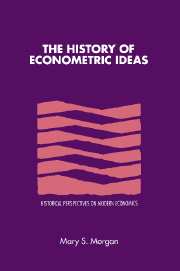Book contents
8 - Haavelmo's probability model
Published online by Cambridge University Press: 26 October 2009
Summary
A ‘probabilistic revolution’ occurred in econometrics with the publication of Trygve Haavelmo's ‘The Probability Approach in Econometrics’ in 1944. It may seem strange that this ‘revolution’ should have been delayed until mid-century for, from the early days of the twentieth century, economists had been using statistical methods to measure and verify the relationships of economic theory. But, even though these early econometricians used statistical methods, they believed that probability theory was not applicable to economic data. Here lies the contradiction: the theoretical basis for statistical inference lies in probability theory and economists used statistical methods, yet they rejected probability. An examination of this paradox is essential in order to understand the revolutionary aspects of Haavelmo's work in econometrics.
At the beginning of the century, applied economists believed that there were real and constant laws of economic behaviour waiting to be uncovered by the economic scientist. As we have seen, this early econometrics consisted of two sorts of activity depending on the status of the theory concerned and the type of law to be uncovered. Where a well-defined and generally agreed theory existed, as in the work on demand, the role of statistical methods was to measure the parameters or constants of the laws.
- Type
- Chapter
- Information
- The History of Econometric Ideas , pp. 229 - 258Publisher: Cambridge University PressPrint publication year: 1990

